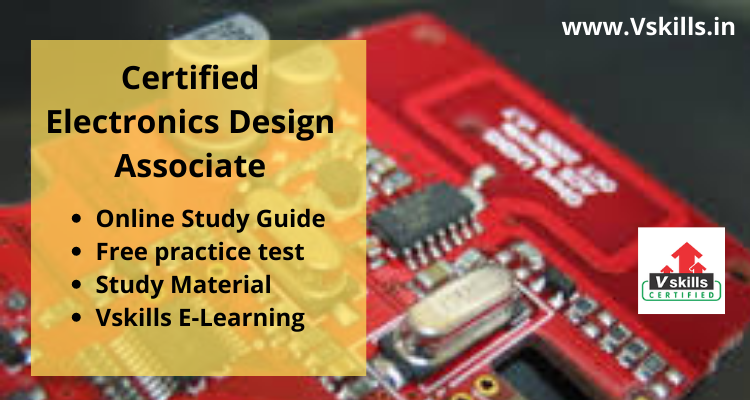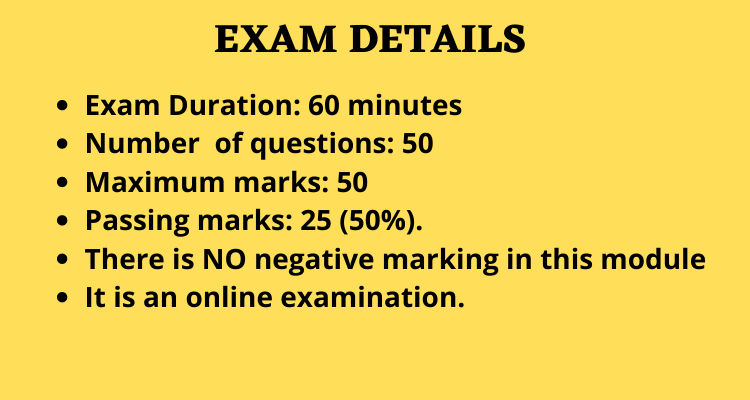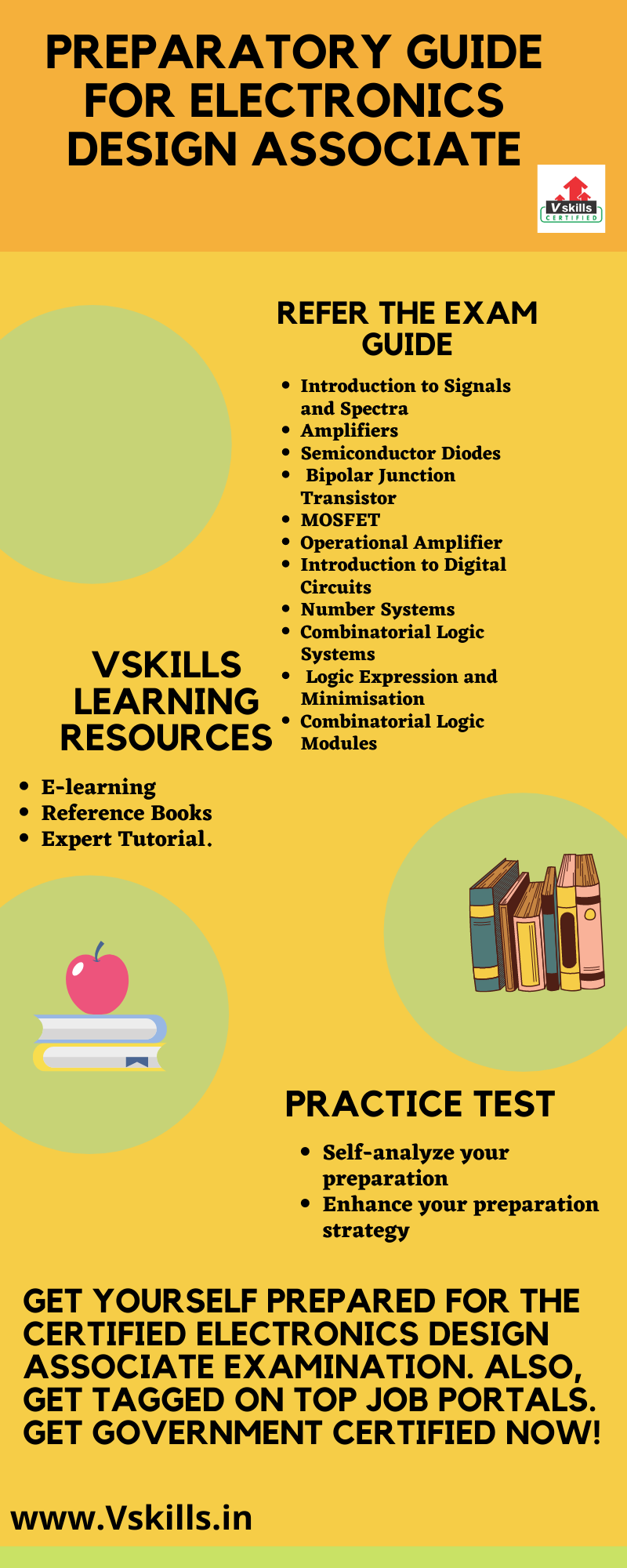Certify and Increase Opportunity.
Be
Govt. Certified Electronics Design Associate
An Electronic Design Associate usually provides technical support designing and developing electronic systems. They coordinate with design team in developing new design ideas and techniques. To add on, they work on creating, designing, and developing everyday devices such as mobile phones, portable music devices, and computers. There are a lot of career opportunities as an Electronic Design Associate.
Electronic Design Associate: Roles and Responsibilities
An Electronic Design Associate is responsible for preparing and designing documentation and engineering specifications according to company standards. To add on, they research and develop the latest technologies and accordingly determine design parameters. Further, they analyze designs to find any issues and develop effective resolutions. Last but not least, review and recommend changes to existing designs to improve performance and quality.
Vskills Electronic Design Associate
The Vskills Electronic Design Associate is designed to help you develop and learn all the relevant skills and knowledge. Moreover, Most Electronics certifications offer mock tests. In the case of Electronics Design Associate Certification, along with the test, the candidate gets a complete e-book of 13 modules – edited by well-known industry professionals and online virtual labs to refresh his knowledge in Electronics.
Benefits of Certification
- Engineering undergraduates, graduates, ITI and polytechnic undergraduates and graduates, working professionals in Electronics looking for a career enhancement can take the Electronics Design Associate Certification.
- To add on, The Indian Electronics Industry is going through a very exciting time. In the last year, the Government has announced a slew of policies to accelerate the domestic production of electronics goods. There is a strong need for standardized certification in Electronics to assess the skill of candidates. A Certified Electronics Design Associate will possess the right skills for the hiring companies looking to hire in this space.
Vskills being India’s largest certification provider gives candidates access to top exams as well as provides after exam benefits. This includes:
- The certifications will have a Government verification tag.
- The Certification is valid for life.
- Candidates will get lifelong e-learning access.
- Access to free Practice Tests.
Test Details
- Exam Duration: 60 minutes
- Number of questions: 50
- Maximum marks: 50
- Passing marks: 25 (50%).
- There is NO negative marking in this module
- It is an online examination
Course Outline for Certified Electronics Design Associate
1. Introduction to Signals and Spectra
This topic briefly introduces the concepts of data , information and signals. It further describes base band signals followed by the types of signals. Finally it presents a brief description on spectrum of signals and the frequency spectrum in general.
2. Amplifiers
This topic initially presents an introduction to a very important concept of amplification and amplifier circuit. Further a few parameters those characterize and quantify the performance of an amplifier have been defined. Four types rather models of amplifiers have been presented based on their input and output signal. Finally frequency response and bandwidth of an amplifier has been discussed in brief.
3. Semiconductor Diodes
Starting from the background of the device diode, the topic continues to basics of semiconductors, formation of the semiconductor diode, theory of practical and ideal diode. It is then concluded with applications like rectifiers and clipping and clamping circuits.
4. Bipolar Junction Transistor
This topic briefly introduces the concepts of basic BJT theory using the concepts of pn junction diodes. It further describes modes of operation of transistors, its characteristic in different modes, Dc analysis of transistor circuits. AC analysis of different amplifier circuits using their h parameter models is presented in brief. Adequate analysis problems have been presented to support the theory
5. MOSFET
In most of the advanced electronic circuits and systems the MOSFET is used as an active device or switch instead of BJTs. This topic introduces MOSFETs and its basic theory along with primary circuit analysis to the readers. Starting with highlighting the limitations of BJTs or TTL circuits, the topic proceeds to MOSFET structure, types, symbols, basic operations and it’s characteristics. For using the device in practical systems, its appropriate biasing is very much necessary. Once the MOSFET is appropriately biased, the circuit becomes ready to process a signal input. Amplification is the most common application of MOSFETs in analog domain. So we present basic concept of amplifier using MOSFET. The three categories of basic MOSFET amplifiers have been presented in adequate brief in this topic along with their analysis. Another most important area of MOSFET applications is electronic switching, rather if one says, “the switching applications of the transistors are the root of modern digital electronic revolution”, it won’t be an exaggeration. Finally, switching application of MOSFET is introduced in brief
6. Operational Amplifier
This topic briefly introduces the concepts of differential amplifiers followed by its most popular integrated circuit form called operational amplifiers or OPAMPs. In fact, initially operational amplifier was considered as a building block for implementing some mathematical operations like addition, summation, differentiation and integration in analogue computers. However, soon it was noticed that it can be used for many other applications besides computations and amplification. Now it is possibly the most frequently used analogue integrated circuit for implementing a broad range of analogue circuit applications. The basic concept of OPAMP is an enhanced form of a differential amplifier. Thus initially we introduce differential amplifier in brief. Further the concept and general block diagram of an OPAMP is introduced along with its characterizing parameters. The OPAMP can be used in two configurations i.e. open loop and closed loop. Though applications designed around open loop configuration i.e. without feedback, are comparatively less in number, closed loop configuration enjoys wide popularity among analogue electronic circuit design. Also the circuit applications can be categorized as linear applications like amplifiers, integrators and differentiators and not linear applications like precision rectifiers and logarithmic amplifiers.
7. Introduction to Digital Circuits
In earlier topics, BJT and MOSFET characteristics were revisited. BJT and MOSFET applications were categorized in two types as linear applications like amplifiers and switching applications those are foundation of digital electronics. Finally for studying the representation of voltage levels in analog systems, the decimal number counting system was demonstrated with an algorithmic approach to count generation. But the digital circuits and systems use system with only two symbols 0 and 1 i.e. binary system. It was discussed that the digital systems are more immune to noise as compared to analog systems, though the implementation procedure may require complex integrated circuits. Finally, a brief comparison of analog and digitals systems is presented
8. Number Systems
Number systems are numerical mathematical counting or measuring tools. Different number systems are used for counting different entities. The most popular and frequently used number system in human day to day life is the decimal number system. Decimal number system is used throughout the world for domestic counting purposes. For example, the whole currency system uses the decimal system and we have 1 (one) rupee, 10 (ten) rupees, 100 (hundred) rupees etc. On the other hand, for counting time, we use a system that uses decimal number symbols but with different counting style. After counting 60 seconds, we count one minute and after counting 60 such minutes, we count one hour. Twelve such hours mark day time and twenty four such hours mark a complete day and counting proceeds to week, month and year etc. Finally, it is obvious that for counting every entity we require a number system. But for counting different objects and entities different number systems may be required. We have already discussed basis concepts of number systems in the first chapter with an example of decimal number system. We have also discussed a number system to represent functioning of digital systems that has only two voltage levels defined in it; namely binary system. It is quiet clear that a number system is basically characterized by its set of symbols and its base.
9. Combinatorial Logic Systems
This topic introduces basic digital logic circuits those are used as building blocks for implementing complex digital circuits and systems. As already discussed, in the eighth topic, these circuits may be implemented using either BJTs or MOSFETs. Before actually starting the study of logic circuits, they are explained using analogous electrical circuits for clear conceptual understanding.
10. Logic Expression and Minimisation
In the ninth topic, we have studied basic digital logic gates circuits like NOT, AND, OR. The outputs of these circuits (represented by Y) are some specific functions of inputs or outputs represented by A and B. It is to be noted here that in all those digital circuits the input or output represented by A, B and Y can assume only two values i.e. 0 or 1. Thus, in a limited sense A, B and Y (or inputs and outputs of digital circuits) are called variables. As already studied in the topic, the output variables can be expressed as functions of input variables using the characteristic equations of each basic digital logic circuit. These equations are called Boolean equations and the related mathematics is called Boolean Algebra after a mathematician George Bool.
11. Combinatorial Logic Modules
This topic introduces a few most commonly used combinational logic blocks for designing practical digital circuits and systems. All these combinational logic blocks use basic logic for their implementation and they are available in commercial integrated circuit packages with different specifications.
- Decoders
- Encoders
- Multiplexers
- Demultiplexers
- Half Adder
- Full Adder
12. Sequential Logic Systems
So far we have studied digital logic circuits of which the outputs are Boolean functions of their current inputs. The outputs of these circuits are not functions of the earlier inputs or outputs. Such circuits are called combinational logic circuits. Sequential systems are the systems in which the output depends not only on the current inputs but also on the current and may be many earlier outputs. Initially, we introduce the basic concept of sequential systems as finite state machines. Further, two types of the state machines named Moore and Mealy machines have been presented in brief. The sequential machines require memory elements to store the earlier state(s) of outputs. So we introduce a basic latch as a memory element that can hold data.
13. Programmable Logic Devices
Programmable logic devices are of high importance not only as non-volatile memory devices but also as digital hardware building components. In this topic, we discuss some basic types of programmable logic devices and further present their applications in digital hardware design.
Preparatory Guide for Electronics Design Associate
When you are preparing for an exam you need consistency and determination throughout your journey towards it. Further, you must follow a study pattern while learning from authentic and genuine resources. This Preparatory Guide will act as a bridge for your career advancements. Let’s discuss step by step:
Study Resource: Exam Objectives
it is important to know the exam related details and topics. This will help candidates to easily start preparing for the exam. Also, for the Vskills Electronic Design Associate, the exam topics to refer to are:
- Introduction to Signals and Spectra
- Amplifiers
- Semiconductor Diodes
- Bipolar Junction Transistor
- MOSFET
- Operational Amplifier
- Introduction to Digital Circuits
- Number Systems
- Combinatorial Logic Systems
- Logic Expression and Minimisation
- Combinatorial Logic Modules
Refer: Vskills Electronic Design Associate Broucher
Study Resource: Vskills E-Learning
For the Vskills Electronic Design Associate examination, our team has provided online study material. Also, this online material for this is regularly updated. Furthermore, e-learning is bundled with hard copy material which helps candidates to improve and update the learning curve for superior and better opportunities.
Refer: Vskills Electronic Design Associate Sample Chapter
Study Resource: Reference Books
Books are man’s best friend. It is important to prepare for the right books. To ease out your hunt for books we have provided a list of books which you can refer to:
- “Contemporary Logic Design” by R H Katz
- “Application-Specific Integrated Circuits” by M J S Smith
- “Modern VLSI Design: Systems on Silicon” by W Wolf
Study Resource: Practice Test
After studying for the examination, it is important to practice sample papers. Practicing sample test will help you analyze your weak areas and strengths. Moreover, you will be able to improve your answering skills that will result in saving a lot of time. So, make sure to find the best practice sources.
Job Interview Questions
Prepare for your next job interview with our latest expert created online interview questions, the questions are designed to enhance your skills and make you job ready.






